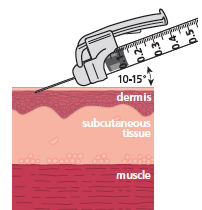
Injection Routes
It is strongly recommended that healthcare workers maintain and follow their facility’s guidelines for aseptic medication preparation and use safety-engineered devices to reduce the risk of needlestick injury after use and to minimize exposure to blood/body fluid.
Intramuscular (IM):
An injection into the muscle tissue (typically less than 3 mL). Large volumes require larger muscles (e.g., vastus lateralis), while smaller volumes (up to 1 mL) can be administered in smaller muscles (e.g., deltoid).
Muscle sites have a good blood supply, which helps the medication to be absorbed more rapidly than by the subcutaneous route. The intramuscular route is also used if a medication is likely to irritate subcutaneous tissue. Some of the drugs given by this route are antibiotics, vitamins, vaccines and fertility drugs.
Intramuscular injections require identification of anatomical markers to assure proper placement.
Important note: infants <18 months old should not receive an IM injection of >0.5 mL.
Subcutaneous (SubQ):
An injection into the fatty layer which lies beneath the dermis. This route is used for small volume injections (≤1 mL) and when the medication is not likely to irritate or damage the subcutaneous tissue. The blood supply to the subcutaneous tissue is less than in muscle tissue; therefore, the absorption rate is generally slower than with IM injections. This is desirable for some medications (e.g., insulin).
Some patients (e.g., malnourished or elderly) may not have enough subcutaneous tissue for a SubQ injection. Check with the prescriber to determine if an alternative route is acceptable.
Skin/Subcutaneous Thickness: Appropriate needle length and injection technique are dependent on the patient’s skin and subcutaneous fat thickness. Intramuscular injections can be avoided with the use of shorter needles.
Injection sites may have different absorption rates. With animal and human insulins, the abdomen has been shown to have the most rapid absorption, the upper arms intermediate, and the thigh and buttocks the slowest absorption. Rotating insulin injections within a site (at least 1” from the previous injection) and using needles only once may avoid the development of lipodystrophy while maintaining a more predictable absorption.
Intradermal (ID):
An injection into the dermis. Only a very small volume of fluid is given (0.1 mL or less). This route is used to test a patient’s sensitivity to allergens or for tuberculin testing.* It is also used for administering local anesthetics. * Due to the risk of anaphylactic reaction, emergency medication and equipment should be available.
If used, allow the alcohol from an alcohol swab to dry completely prior to injection.
Following administration, do not apply pressure or massage injection site.
Inject with the needle bevel up.
If a wheal, or bleb, does not appear during administration, the medication is being delivered into the subcutaneous tissue.






